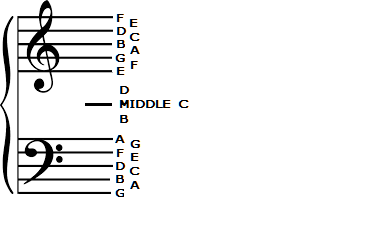Music Theory - Lesson #1
I have been playing guitar off and on for as long as I can remember now. I'm no rockstar and there are people out there who can play circles around me but whenever I ask anyone who does play guitar if they know the theory they usually reply, "No, I don't". I have inquired about taking guitar lessons but when I ask the teacher if they will teach me the theory they say, "No". I don't want to pay someone $10 to $20 an hour to just show me chords or songs that I can learn on my own.
Mabe it's the curious streak in me but I have always wanted to understand where the chords come from and why they are used the way they are used. I have an easier time learning something when I understand the internal workings. I decided to take the bull by the horns and learn on my own and now I want to share this knowlege with others who also want to learn how music works. Don't let me scare you off, music theory is easy to understand and when taken in small progressive doses it makes sense.
I am going to post a lesson every week on Steemit and bit by bit teach other people how music works. I will keep it simple and I am also going to relate it to the guitar although it doesn't matter what instrument you play it works the same for any instrument. So let's get started.
LESSON #1 - The Music Staff
There are two music staves, the treble staff or treble clef and the bass staff or bass clef. When they are written as below with the line connecting the two and the brace at the beginning this is called the grand staff. Each staff consists of five lines and four spaces. The names of the lines and spaces are as in the diagram below.

The treble clef is refered to as the G clef because the curl of the symbol at the beginning of the staff circles the G line and the bass clef is refered to as the F clef because the two dots of the symbol at the beginning of the staff are above and below the F line.
You will notice that there is a short line and three notes between the treble clef and bass clef. The line is called a ledger line and the note it represents is Middle C. There are notes below and above this line and they are of course B and D respectively. These three notes complete the musical alphabet between the staves.
An easy way to remember the names of the lines and spaces for the two staves is to memorize these little rhymes:
The lines of the bass clef from bottom to top can be remembered by memorizing the rhyme Good Boys Deserve Fudge Always and the spaces can be remembered by memorizing the ryme All Cows Eat Grass.
The lines of the treble clef from bottom to top can be remembered by memorizing the rhyme Every Good Boy Deserve Fudge and the spaces can be remembered by realizing that the names of the notes spell the word FACE.
Something to keep in mind is that the lower the note is on the staff the lower the pitch of the note, and the higher the note is on the staff the higher the pitch of the note.
I don't want to overload anyone so I will stop here and we will continue next week with lesson #2. Feel free to ask questions and make comments below. In the meantime Steem on.
Please continue with next lesson and as always with simplicity
I definitly will. Thanks.
Simply Great Information and Presentation
Thank you.